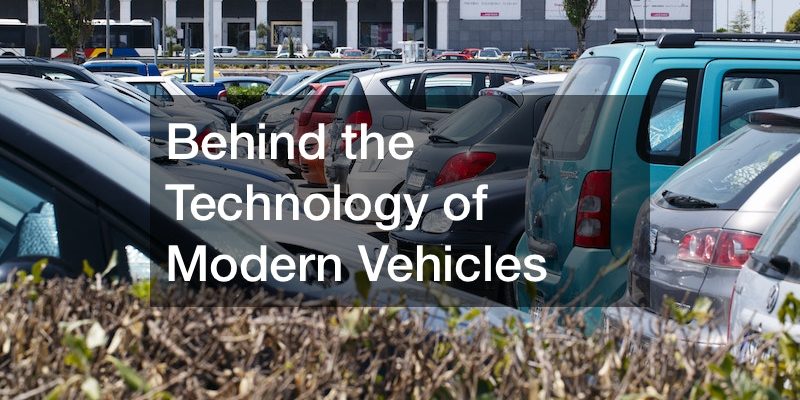
Modern-day vehicles are something to truly marvel at. So many changes and updates have been made to make cars safe, more efficient, and of better value than ever before. Tons of changes have been made to a highly developed automotive industry now that make them something you really want to invest in and ride in. So, what are some of these changes? Keep reading to find out.
Heating Systems

Until the 1950s, there was no real way to regulate the interior temperature of vehicles save by opening windows and hoping that airflow would help. In the 1950s, the first standard heaters became part of the construction of normal cars. These standard heaters have come a long way from where they first started in the 1950s.
We now have auto heating system options that help warm the interior of the car and regulate the temperature based on the overall temperature outside. There are even heated steering wheels and seats. These systems can be maintained and repaired in Honda repair shops if they are damaged. When it comes to heating your vehicle, there are now more heating options and heating technologies than ever before. Thanks to a highly developed automotive industry, we can enjoy these technologies in our vehicles.
Brake Systems

Another huge update in the technology for cars is the brake controllers and braking systems. Brakes were part of most cars when they were first invented in the early 1900s, while the modern braking system we see now on all four wheels was developed in 1929. We now have a huge range of different types of brakes in cars that can help stop your vehicle and make it safer.
The first type of brakes that were very common were drum brakes. These are made up of a drum that rotates with the wheels, and a caliper clamps down to stop the motion of the wheel. These drum brakes are fairly common and are still widely used across the board and in many older cars as well. This innovation developed automotive products to the point we know today.
In the 1950s, the disc brake was developed. With disc brakes, a disc is clamped by calipers to help stop the motion of the wheels. This type of braking system is very common in new cars and does help make cars safer and easier to stop overall. Being sure your brakes are in good shape and you get appropriate car brake repair can help keep your car safe.
While this was previously technology you had to apply yourself by pressing the brake pedal, there are also cars now that will put on the brakes for you, by automatically braking and working with you to ensure you are braking when needed.
Stereo Systems

This is another huge leap that has been made for cars as we know them. Cars did not have stereos when they were first created; they were simply not a part that was essential to the function of the car. Therefore, they were not something that was put in vehicles.
In the 1920s (1926, to be exact), Philips helped create the radio that would be put into cars regularly.
These stereos were very basic. They did not have any extra features that would make them distinctive or anything like what we see today. These radios were simple; they got radio stations, and that was about it. Stereo systems as we know them now developed automotive media experiences.
The radios and stereo systems we have now are much more evolved and more interesting than stereos that were once commonplace. Modern stereos are significantly more advanced. They get radio stations. You can get subscription radio stations. They can play cassette tapes and CDs. And they can even use Bluetooth to connect with your mobile phone or other devices. When connected to a cell phone,
you can make phone calls, use wayfinding apps for driving directions, listen to the library on your phone, and much more, all through the vehicle’s stereo system. With these features, you can take your time and listen to what you want when you are in the car. The car stereo system is something that has certainly evolved over the past few decades.
Electronic Systems
The adaptation of electronic systems specifically for installation in vehicles is perhaps the biggest change that has developed automotive products as we know them today since they were first invented. First-generation cars were basic and weren’t planned to involve electronics of any sort. Clocks and other electronic devices and systems began to be put into cars in the 1970s. FIAT was one of the first companies to put electronics in their cars. Car electronics are truly impressive and interesting, and there are so many different systems out there now.
The electronic systems we now have in place are something that is truly fantastic. These systems can do so much for the driver and can add so much to the vehicle overall. Modern electronic systems installed in vehicles help you make calls, park your car, give voice commands to your car, and more. These systems are honestly remarkable.
Electrical systems in cars today can do nearly everything. There are even cars that run completely on electricity, and some can be driven autonomously by the electrical system of the vehicle itself. These systems can also help you be more aware of your surroundings, make you aware of the other drivers around you, and let you feel completely comfortable in your vehicle. These systems developed automotive practices to a more advanced technological state.
Wheels and Tires

Vehicle tires and wheels are another major innovation that has come a long way. New tires are made better than before. They are made to last longer than prior models. And they are made to help cushion the road and make the ride overall smoother. The first tires that were put on automobiles were first invented in 1888. They had a wire frame covered in smooth rubber filled with air. Tires of this design were often referred to as balloon tires.
The tread style we are so used to now on tires was not invented or introduced until 1905. These treads were created to help create more traction on the wheel to improve the car in terms of overall drivability and help the driver control the vehicle. Tire treads make it possible to drive the car and even have the traction needed to be able to drive in inclement weather conditions such as rain and snow.
Initially, there was not much variety in the tires that were part of the original design of the vehicle. The tires we use now on our vehicles are varied and tailored to the type of driving that we do. If you drive off-road a great deal, you can get tires that are a bit softer and have a deeper tread. If you drive on streets only, you can get tires that are harder and have shallower treads to be able to handle the wear and tear that comes with that lifestyle.
Modern tires in today’s developed automotive industry also have a series of metal bands that run through the tire to give it structure, help keep it in the shape that it needs to be in, and make it a bit more durable. Tires are a significant part of your vehicle’s functionality, as are the rims that you put your tires on. These have also been updated greatly. There are now more styles and types of rims than ever before. You can get some great designs to reflect the way you drive as well as your own personal tastes.
Body Shapes, Sizes, and Materials
The shapes and body styles of vehicles have also changed. There are now more body styles, shapes, sizes, and varieties of vehicles than ever before. When the first automobile was designed, there was one style, and that was the only car out there you could get. As cars became more popular and there was more interest in owning automobiles, the styles of vehicles that were available became more varied.
Currently, there are over 400 different makes of automobiles you can purchase today. There are about 14 major corporations and over 60 different car makers in today’s highly developed automotive industry as well. This means that there are so many different cars to choose from now, you can make your choice based on your specific needs and particular preferences.
Safety Features
Safety measures have developed automotive products in a major way since they were first developed and put on the market. The first lap belt was developed in the 1930s and was not available in every car. The shoulder belt would not be developed until years later, in 1958, by Volvo. The first airbag was not invented until the 1970s. And airbags were not prevalent on the passenger side of vehicles until the 1990s. In general, airbags were not a required feature in cars until 1998.
Real progress in safety did not start to take place until the 1950s when the fatality rates for people in cars started to skyrocket. There are now more safety features than ever before in every single car released for purchase. Things like airbags (including on the passenger side and even in the backseat), seatbelts, safety glass that does not shatter, cameras and alert systems, and more are now commonplace in most vehicles.
Cars are safer now than they have ever been before. The overall safety testing system that is now in place did not start until the 1930s. The test that is currently common and that all automobiles have to undergo is a major selling point for most buyers. Car makers cannot sell vehicles if they do not meet the basic safety guidelines that have been set forth. Auto safety standards as we know them have become commonplace in developed automotive products today.
Car Care and Maintenance
As if that was not enough, there have also been many changes made related to the overall maintenance and care of vehicles. There are now more options for jump start services, carburetor installation, and more. There are also many mechanics out there who specialize in different types of repairs or alterations to vehicles. You can even find used trailers to be worked on.
You can find great car care if you just take the time to ensure you have found the right mechanic and the right shop to take care of your vehicle. There have always been people who could work on cars and help repair them, but a career as a mechanic was not really very common. There are now more options than ever before when it comes to being sure your car is well cared for, maintained to work well, and repaired to keep running down the road.
Cars have changed so much in the past few decades. There are now more features, systems, and processes than ever before that make it possible for drivers and passengers to ride safely and comfortably in their cars and to ensure they will arrive where they are going. Cars have changed dramatically since they were invented in 1886. Modern vehicles are almost unrecognizable compared to the cars that were first invented. There are now more cars, more styles, and more features than ever. All these options and customizations make it easy to find a car that is going to work for you and truly make you happy.
In fact, the developed automotive world as we know it today is sure to change even more as we continue through the decades, and as more and more people get into the car-making industry. Plus, the way we think of cars today will continue to evolve. There are sure to be more innovations and more changes in the technology we see in cars. Maybe one day, we will have cars that fly, cars that drive themselves without wrecking, and cars that work for us.



